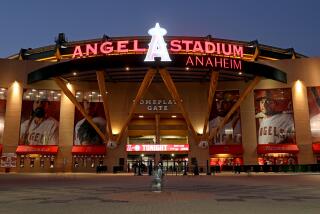Disneyland-Area Rehab OKd : Tourism: Anaheim planners adopt $172-million plan to erase decay. It is called key to Disney’s proposed $3-billion resort. Council action is next.
- Share via
ANAHEIM — Amid rising concerns about financing, the city Planning Commission approved an ambitious $172-million revitalization plan Monday aimed at erasing urban decay around Disneyland.
“That area is deteriorating,” Planning Commission Chairwoman Phyllis Boydstun said. “We’ve got to improve that area so the city can go out and sell itself. Visitors are going to spend big bucks; we want to have an entrance to the area that will make them feel like they have arrived somewhere special.”
The Planning Commission’s 5-1 vote represents an important step forward in the city’s drive to remain competitive in the tourism industry, officials said. The plan covers 550 acres around the theme park and is designed to encourage development and boost tax revenue.
The so-called “Anaheim Resort” plan also would permit up to 16,000 new hotel rooms, and is viewed as a pivotal complement to a proposed $3-billion Disneyland Resort.
The plan still requires the approval of the City Council, which is expected to vote by the end of September.
At Monday’s five-hour hearing, several prominent business leaders, including Disney officials, pressed city officials to outline exactly who will have to pay the $172.5 million in proposed sewer, street and landscaping improvements.
“The ways and means of financing these plans needs to be satisfactorily addressed,” said Disneyland Vice President Ron Dominguez, who nevertheless endorsed the plan. “Infrastructure priorities need to be set and agreed upon.”
City proposals call for the area upgrades to be funded by an increase in the hotel bed tax, from 13% to 15%, and a combination of federal, state and county funds. The balance of the improvements would be paid by developers in the targeted area based on a “fair share” formula.
Deputy City Manager Tom Wood said the City Council will determine the specifics of the fair share plan. Public hearings also will be held, he said.
“I don’t like to deal with this level of vagueness myself,” Wood told concerned business owners.
Under the city plan, the resort area would be a heavily landscaped district, with wide sidewalks. Utility lines would be buried, and businesses would be asked replace gaudy signs with more modest ones.
Planning Commissioner Mitchell T. Caldwell, who supported the overall plan, cast the only dissenting vote. Caldwell had asked city officials to earmark a portion of future resort area revenue for schools and low-income housing.
“Our neighborhoods are going to hell,” Caldwell said after the meeting. “We are missing an opportunity to do something about it today.”
City officials conceded Anaheim currently lacks the facilities to house thousands of low-income workers, who are expected to staff the new hotels. Also, city officials acknowledged local schools will not receive enough state funding to cover the extra cost in the increased student enrollment created by the plan.
But Wood said it would be unwise to “lock the hands” of the city now with the such a funding requirement. Wood added the plan should be approved now, and future city councils can allocate school and housing funds when revenue streams into the city.
During the hearing, four members of a nearby homeowners association criticized the proposal as a taxpayer gift to Disney. They urged the commission to revise the plan.
“Michael Eisner makes between $100 million and $200 million. Let him take a pay cut and fund it himself,” said Steve White, one of some 2,000 members of HOME (Homeowners Maintaining their Environment). “It’s a welfare program for a successful multinational corporation.”
The commission also approved a draft environmental impact report for the plan. Among the impacts identified in the EIR were traffic congestion at four intersections, reduced air quality and the loss of 56 acres of prime agricultural land (a strawberry field north of Disneyland).
Garden Grove officials also spoke against the plan, charging the EIR failed to consider the plan’s impact on neighboring cities.
The Anaheim Resort district includes Disneyland, the Anaheim Convention Center and most of the area’s high-rise hotels. The triangular area is bounded by Orangewood Avenue, Walnut Street, Haster Street and the Santa Ana Freeway
City officials have stated the economic benefits outweigh the adverse impacts. The area currently contributes between $7 million and $10 million annually in net revenue to the city. Officials estimate, when completed, the rejuvenated area would create 60% more in city funds.
More to Read
Sign up for Essential California
The most important California stories and recommendations in your inbox every morning.
You may occasionally receive promotional content from the Los Angeles Times.













